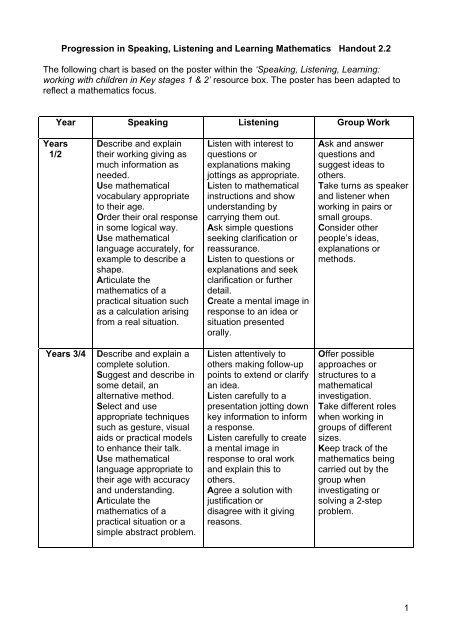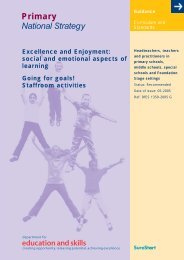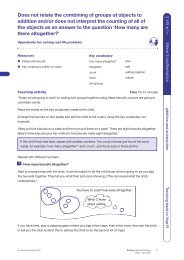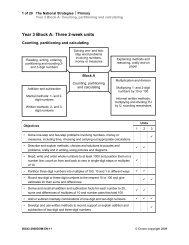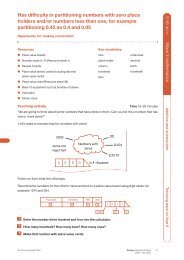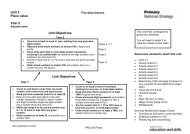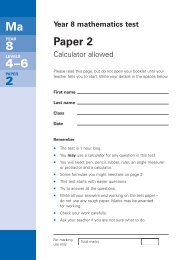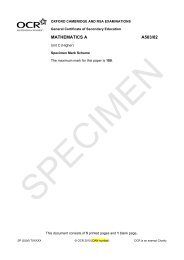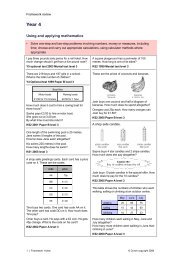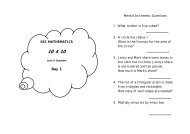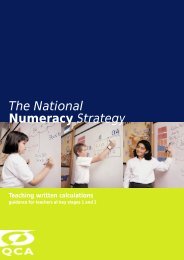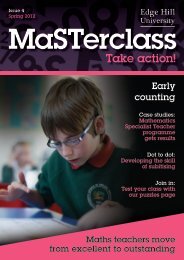Speaking, Listening and Learning in Mathematics
Speaking, Listening and Learning in Mathematics
Speaking, Listening and Learning in Mathematics
You also want an ePaper? Increase the reach of your titles
YUMPU automatically turns print PDFs into web optimized ePapers that Google loves.
Progression <strong>in</strong> <strong>Speak<strong>in</strong>g</strong>, <strong>Listen<strong>in</strong>g</strong> <strong>and</strong> <strong>Learn<strong>in</strong>g</strong> <strong>Mathematics</strong> H<strong>and</strong>out 2.2The follow<strong>in</strong>g chart is based on the poster with<strong>in</strong> the ‘<strong>Speak<strong>in</strong>g</strong>, <strong>Listen<strong>in</strong>g</strong>, <strong>Learn<strong>in</strong>g</strong>:work<strong>in</strong>g with children <strong>in</strong> Key stages 1 & 2’ resource box. The poster has been adapted toreflect a mathematics focus.Year <strong>Speak<strong>in</strong>g</strong> <strong>Listen<strong>in</strong>g</strong> Group WorkYears1/2Describe <strong>and</strong> expla<strong>in</strong>their work<strong>in</strong>g giv<strong>in</strong>g asmuch <strong>in</strong>formation asneeded.Use mathematicalvocabulary appropriateto their age.Order their oral response<strong>in</strong> some logical way.Use mathematicallanguage accurately, forexample to describe ashape.Articulate themathematics of apractical situation suchas a calculation aris<strong>in</strong>gfrom a real situation.Listen with <strong>in</strong>terest toquestions orexplanations mak<strong>in</strong>gjott<strong>in</strong>gs as appropriate.Listen to mathematical<strong>in</strong>structions <strong>and</strong> showunderst<strong>and</strong><strong>in</strong>g bycarry<strong>in</strong>g them out.Ask simple questionsseek<strong>in</strong>g clarification orreassurance.Listen to questions orexplanations <strong>and</strong> seekclarification or furtherdetail.Create a mental image <strong>in</strong>response to an idea orsituation presentedorally.Ask <strong>and</strong> answerquestions <strong>and</strong>suggest ideas toothers.Take turns as speaker<strong>and</strong> listener whenwork<strong>in</strong>g <strong>in</strong> pairs orsmall groups.Consider otherpeople’s ideas,explanations ormethods.Years 3/4Describe <strong>and</strong> expla<strong>in</strong> acomplete solution.Suggest <strong>and</strong> describe <strong>in</strong>some detail, analternative method.Select <strong>and</strong> useappropriate techniquessuch as gesture, visualaids or practical modelsto enhance their talk.Use mathematicallanguage appropriate totheir age with accuracy<strong>and</strong> underst<strong>and</strong><strong>in</strong>g.Articulate themathematics of apractical situation or asimple abstract problem.Listen attentively toothers mak<strong>in</strong>g follow-uppo<strong>in</strong>ts to extend or clarifyan idea.Listen carefully to apresentation jott<strong>in</strong>g downkey <strong>in</strong>formation to <strong>in</strong>forma response.Listen carefully to createa mental image <strong>in</strong>response to oral work<strong>and</strong> expla<strong>in</strong> this toothers.Agree a solution withjustification ordisagree with it giv<strong>in</strong>greasons.Offer possibleapproaches orstructures to amathematical<strong>in</strong>vestigation.Take different roleswhen work<strong>in</strong>g <strong>in</strong>groups of differentsizes.Keep track of themathematics be<strong>in</strong>gcarried out by thegroup when<strong>in</strong>vestigat<strong>in</strong>g orsolv<strong>in</strong>g a 2-stepproblem.1
Years 5/6Present a multi-stepsolution.Use mathematicallanguage with <strong>in</strong>creas<strong>in</strong>gaccuracy <strong>and</strong> use itwhen describ<strong>in</strong>geveryday objects e.g.use language such assuch as pyramid <strong>and</strong>prism <strong>and</strong> semi-circle asopposed to half a circle.Show the use ofmathematical language<strong>in</strong> a range of contexts<strong>and</strong> purposes eg use thelanguage of likelihood ifappropriate whenstructur<strong>in</strong>g a conv<strong>in</strong>c<strong>in</strong>gargument or counterargument.Reflect on the solution toa problem <strong>and</strong> structurea logical explanation topresent to others.Extract <strong>and</strong> articulate theabstract mathematicswith<strong>in</strong> or from a practicalsituation or contextListen attentively toidentify the key featuresof a mathematicalargument or counterargument.Analyse <strong>and</strong> evaluatethe key features of amathematical argument.Use the key features of amathematical argumentto solve a problem orprovide constructivefeedback.Create a mental image<strong>and</strong> manipulate it <strong>in</strong>response to <strong>in</strong>structions.Offer <strong>and</strong> justify achallenge to an ideaby expla<strong>in</strong><strong>in</strong>g itsconsequences.Present <strong>and</strong> justify apossible approach toa problem or<strong>in</strong>vestigation seek<strong>in</strong>gfeedback from groupmembers.Contribute to therigour with which thegroup carries out itsmathematics show<strong>in</strong>g<strong>in</strong>creas<strong>in</strong>glysophisticated logic,coherence <strong>and</strong>articulation.Possible activities for develop<strong>in</strong>g <strong>Speak<strong>in</strong>g</strong> <strong>and</strong> listen<strong>in</strong>g <strong>in</strong> mathematics.The Polish<strong>in</strong>g Pen (l<strong>in</strong>ked to literacy!)Record a child’s explanation/justification/ reason<strong>in</strong>g <strong>in</strong>vite the class to use the ‘polish<strong>in</strong>g pen’ toredraft/extend the response. Children use mathematical vocabulary cards <strong>and</strong> work<strong>in</strong>g walls tostructure this process.Expla<strong>in</strong> your method/reason<strong>in</strong>gExpla<strong>in</strong> to a partner, group or class how you worked someth<strong>in</strong>g out or why you believe someth<strong>in</strong>gto be correct/true. Any calculation or problem solv<strong>in</strong>g work can provide opportunities for pupils toexpla<strong>in</strong> their chosen strategy to others, allow<strong>in</strong>g peers to make <strong>in</strong>dependent choices about themost effective strategy available to them. <strong>Listen<strong>in</strong>g</strong> partner has to offer reasons why s/he agreeswith the chosen strategy <strong>and</strong>/or offer an alternative strategy.Promote the vocabulary of reason<strong>in</strong>g:• It could be… because…• It can’t be……because• It won’t work, because….• If…then….• It would only work if…..The follow<strong>in</strong>g activities require the pupils to determ<strong>in</strong>e which number is represented by each letterwith<strong>in</strong> the context of multiplication facts <strong>and</strong> expla<strong>in</strong> how they know.2
For example: In mystery tables the digits <strong>in</strong> multiplication tables are replaced by letters. The taskis to work out which number is represented by each letter <strong>and</strong> why.In mixed up multiplication grids the multiplication tables from 1 x 1 to 9 x 9 are designed so thatrows <strong>and</strong> columns are <strong>in</strong> the wrong orders. Once aga<strong>in</strong> letters st<strong>and</strong> for the digits 0 – 9 <strong>and</strong> thetask is to crack the codeIn ‘Who wants to be a millionaire?’ provide a question <strong>and</strong> 4 possible answers to discuss. Theactivity can be made more fun by <strong>in</strong>corporat<strong>in</strong>g ‘Phone a friend’, ‘Ask the audience’ <strong>and</strong> ’50 / 50’.This game can reduce the pressure on less confident children <strong>in</strong> hav<strong>in</strong>g to calculate an answer atspeed. However it provides opportunities for them to discuss their th<strong>in</strong>k<strong>in</strong>g with peers, justify<strong>in</strong>g<strong>and</strong> communicat<strong>in</strong>g their reason<strong>in</strong>g.In ‘Always true, sometimes true, never true’ the activity requires pupils to articulate <strong>and</strong> justifytheir reason<strong>in</strong>g. Given a statement, decide whether it is always, sometimes or never true, justify<strong>in</strong>gyour reason<strong>in</strong>g with specific examples where possible. Statements such as: multiplication by apositive number makes positive numbers larger; the total of 2 consecutive numbers is always odd,divid<strong>in</strong>g a number by one half makes the answer twice as big….‘Guess my rule’ can be played as a whole class, <strong>in</strong> groups or <strong>in</strong> pairs. In each case, a po<strong>in</strong>tsystem could be <strong>in</strong>troduced, enabl<strong>in</strong>g children to w<strong>in</strong> more po<strong>in</strong>ts the fewer clues they require.Pupils can ask 10 questions, which have to be answerable with yes or no, to identify the chosennumber. With a limit of 10 questions, the children have to listen very carefully to each other <strong>and</strong>consider the most helpful type of question, so as not to waste their chances.Pupil/team A select a one or two stage rule (function mach<strong>in</strong>e). Pupil/team B provides a suggested<strong>in</strong>put number. Pupil/team A respond with the correspond<strong>in</strong>g output number. Pupils then try toidentify the rule which has changed the <strong>in</strong>put to the output. Pupils cont<strong>in</strong>ue to suggest <strong>in</strong>putnumbers <strong>and</strong> receive the correspond<strong>in</strong>g output number until they are able to correctly identify therule. Pupils may come to realise that the rule is easier to identify if they use a strategy eg. try low,consecutive numbers‘Just a m<strong>in</strong>ute’Ask children to take turns to talk for just a m<strong>in</strong>ute on an aspect of calculat<strong>in</strong>g eg How do you checkyour answers? Do you prefer addition or subtraction calculations - why?Take a st<strong>and</strong>Put a statement <strong>in</strong> the middle of a group of children. Give each child their name card. Children toput their name card as close / far away from the statement depend<strong>in</strong>g on how confident they are <strong>in</strong>say<strong>in</strong>g someth<strong>in</strong>g about the statement.e.g the sum of any 3 consecutive numbers is divisible by 3.They could agree / disagree with this statementThey could def<strong>in</strong>e consecutive or divisible.They could give examples.Is very important that all children are encouraged to speak <strong>and</strong> listen, so even if they can th<strong>in</strong>k ofnoth<strong>in</strong>g orig<strong>in</strong>al to say, they can still repeat what another child has said <strong>and</strong> agree / disagree withit.Ensure all children know the rules for speak<strong>in</strong>g <strong>and</strong> listen<strong>in</strong>g - establish ground rules first:• no talk<strong>in</strong>g when someone else is talk<strong>in</strong>g• only speak when you are hold<strong>in</strong>g the 'microphone' (could be a ‘pencil’)• th<strong>in</strong>k about what the person is say<strong>in</strong>g <strong>and</strong> ask yourself if you agree or disagree3


